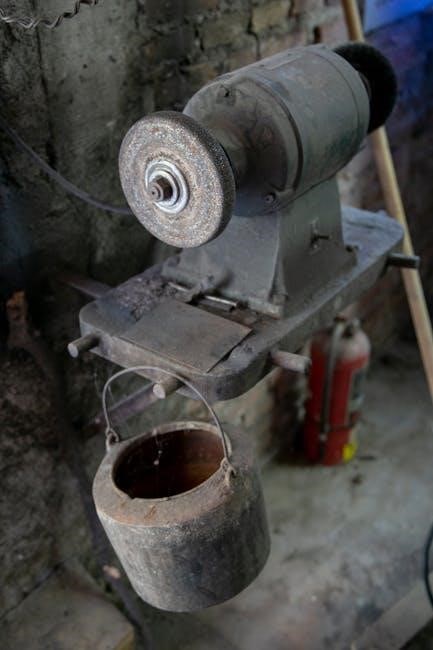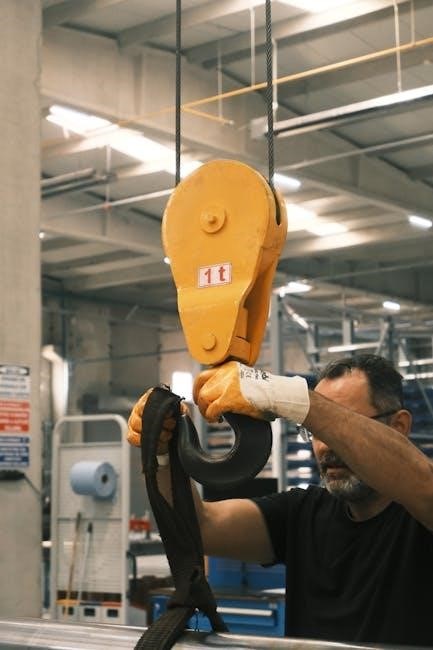Okay‚ here is the text for the “Singer Heavy Duty 4411 Manual: A Comprehensive Guide” section:

Singer Heavy Duty 4411 Manual: A Comprehensive Guide
Embark on a seamless sewing journey with the Singer Heavy Duty 4411! This comprehensive guide serves as your ultimate companion‚ unlocking the full potential of your robust sewing machine. From threading to troubleshooting‚ discover expert tips and clear instructions‚ ensuring successful and creative projects every time.
The Singer 4411 Heavy Duty sewing machine stands as a reliable and versatile tool‚ designed to tackle a wide array of sewing projects‚ from delicate fabrics to heavy-duty materials like denim and canvas. Known for its robust construction and powerful motor‚ this machine offers enhanced sewing speed‚ allowing users to complete their projects efficiently.
Equipped with essential utility stitches and simple setup‚ the Singer 4411 is suitable for sewists of all skill levels. Its full metal frame ensures durability and stability during operation‚ while its various stitch applications provide flexibility in creative endeavors. Whether you’re a beginner or an experienced sewer‚ this machine offers a user-friendly experience with consistent performance.
This sewing machine is an electric-powered marvel designed for various sewing tasks. The free arm feature further enhances its versatility‚ enabling easy sewing of cylindrical items like sleeves and pant legs. Weighing in at 7600 grams‚ with a width of 170 millimeters and a height of 300 millimeters‚ it strikes a balance between portability and sturdiness.
Accessing the Singer 4411 Heavy Duty Instruction Manual
Unlocking the full potential of your Singer 4411 Heavy Duty sewing machine begins with accessing its comprehensive instruction manual. Whether you’ve misplaced the physical copy or prefer a digital version‚ several avenues are available to obtain this essential resource. The manual serves as your guide to understanding the machine’s features‚ operation‚ and maintenance.
Singer offers digital manuals on their official website‚ often in PDF format‚ allowing for easy download and access on various devices. These manuals typically include detailed diagrams‚ step-by-step instructions‚ and troubleshooting tips. Many third-party websites also host Singer sewing machine manuals‚ providing alternative sources for retrieval.
When searching online‚ be sure to specify the exact model number (4411 Heavy Duty) to ensure you obtain the correct manual for your machine. If a digital version isn’t readily available‚ consider reaching out to authorized Singer service centers or retailers‚ who may offer printed copies or further assistance in locating the manual. This ensures clear‚ concise instructions right at your fingertips.
Key Features and Specifications of the Singer 4411
The Singer 4411 Heavy Duty sewing machine is renowned for its robust construction and user-friendly design‚ making it a popular choice for both beginners and experienced sewists. Key features include a powerful motor capable of handling a wide range of fabrics‚ from delicate silks to heavy denim and canvas. Its high sewing speed allows for efficient completion of projects.
The machine boasts a full metal frame‚ ensuring durability and stability during operation. It offers a selection of essential utility stitches‚ providing versatility for various sewing tasks. The free arm feature facilitates sewing cylindrical items‚ such as sleeves and pant legs‚ with ease. Adjustable presser foot pressure accommodates different fabric thicknesses.
Specifications include a weight of approximately 7600 grams‚ a width of 170 millimeters‚ and a height of 300 millimeters. The Singer 4411 operates electrically and includes features like a two-step presser foot lifter. Understanding these features and specifications allows users to maximize the machine’s capabilities and achieve optimal sewing results.
Safety Instructions and Guidelines

Prioritizing safety is crucial when operating the Singer 4411 Heavy Duty sewing machine. Always read the instruction manual thoroughly before use to understand all safety precautions. Ensure the machine is switched off (O) before making any adjustments in the needle area‚ such as threading‚ changing the needle‚ or replacing the bobbin.
Keep fingers clear of moving parts‚ especially the needle‚ to prevent injury. Use the appropriate presser foot for the fabric being sewn to avoid needle breakage. Never operate the machine if it is damaged or malfunctioning. Regularly inspect the power cord for any signs of wear or damage and replace if necessary.
When not in use‚ unplug the machine from the power outlet. Provide adequate lighting to ensure clear visibility of the sewing area. Store the machine in a safe‚ dry place‚ away from children and pets. Following these safety instructions and guidelines will help ensure a safe and enjoyable sewing experience with the Singer 4411 Heavy Duty.
Setting Up Your Singer 4411 for Sewing
Before you begin sewing with your Singer 4411 Heavy Duty‚ proper setup is essential for optimal performance. Start by placing the machine on a stable‚ flat surface. Connect the power cord to both the machine and a grounded electrical outlet. Ensure the foot pedal is within comfortable reach.
Next‚ install the appropriate needle for your fabric type. Loosen the needle clamp screw‚ insert the needle with the flat side facing the back‚ and tighten the screw securely. Select the desired presser foot and attach it to the machine. Ensure it is firmly in place before proceeding.
Prepare your workspace by gathering your fabric‚ thread‚ scissors‚ and any other necessary sewing tools. Position your fabric to the left of the needle‚ ready for sewing. By following these initial setup steps‚ you’ll be well-prepared to start your sewing project with the Singer 4411 Heavy Duty‚ ensuring smooth and accurate stitches.
Threading the Needle and Bobbin
Threading the needle and bobbin correctly is crucial for achieving consistent and even stitches with your Singer 4411 Heavy Duty. Begin by raising the presser foot and positioning the thread spool on the spool pin. Follow the threading guide‚ ensuring the thread passes through each designated point.
Pull the thread through the tension disc and then through the take-up lever‚ making sure it’s properly seated. Finally‚ thread the needle from front to back. For the bobbin‚ wind the thread evenly onto the bobbin‚ following the machine’s bobbin winding mechanism.
Insert the filled bobbin into the bobbin case‚ ensuring it rotates in the correct direction. Draw the bobbin thread up through the needle plate by holding the needle thread gently while turning the handwheel towards you. With both threads now correctly positioned‚ you are ready to begin sewing.
Refer to your Singer 4411 manual for detailed diagrams and specific instructions if you encounter any difficulties during the threading process‚ ensuring a smooth and frustration-free sewing experience.
Understanding Stitch Patterns and Adjustments

The Singer Heavy Duty 4411 offers a selection of built-in stitch patterns‚ each designed for specific sewing tasks. Understanding these patterns and how to adjust them is key to unlocking the machine’s full potential. Consult your manual for a detailed overview of each stitch‚ including its recommended applications and settings.
Adjusting stitch length and width allows for fine-tuning the appearance and durability of your seams. Experiment with different settings on scrap fabric to achieve the desired result before working on your project. The tension dial also plays a vital role‚ ensuring balanced stitches on both sides of the fabric.
Incorrect tension can lead to looping or puckering‚ so adjust it carefully until the stitches appear uniform. Furthermore‚ familiarize yourself with the reverse sewing lever‚ which is essential for securing seams and preventing unraveling.
By mastering these stitch patterns and adjustments‚ you can confidently tackle a wide range of sewing projects with your Singer 4411‚ achieving professional-quality results every time‚ with minimal effort.
Adjusting Presser Foot Pressure
The Singer Heavy Duty 4411 allows for adjusting the presser foot pressure‚ a crucial feature for accommodating various fabric thicknesses. The presser foot exerts pressure on the fabric as it feeds through the machine‚ and adjusting this pressure ensures even stitching and prevents fabric distortion.
For lightweight fabrics like silk or chiffon‚ reducing the pressure is essential to prevent puckering or slippage. Conversely‚ heavier fabrics like denim or canvas require increased pressure to maintain consistent feeding and prevent skipped stitches. Locate the presser foot pressure adjustment dial or screw on your machine‚ consulting your manual for its specific location and operation.
To decrease pressure‚ turn the dial counter-clockwise; to increase it‚ turn it clockwise. Test the pressure on a scrap piece of the fabric you’ll be using‚ observing how it feeds and stitches. If the fabric is bunching up‚ reduce the pressure; if it’s slipping or the stitches are uneven‚ increase it.
Properly adjusting the presser foot pressure is a simple yet effective way to enhance the quality of your sewing and achieve professional-looking results with your Singer 4411.
Troubleshooting Common Issues
Even with a reliable machine like the Singer Heavy Duty 4411‚ occasional issues may arise. Understanding common problems and their solutions can save time and frustration. One frequent concern is thread breakage‚ often caused by incorrect threading‚ improper tension settings‚ or using the wrong needle for the fabric.
Re-threading the machine carefully‚ ensuring the thread is correctly seated in all guides and tension discs‚ is the first step. Adjusting the tension‚ usually by slightly loosening the upper thread tension for breakage or tightening it if the stitches are too loose‚ can also resolve the issue. Skipped stitches are another common problem‚ typically resulting from a bent or damaged needle‚ incorrect needle insertion‚ or improper timing.
Replacing the needle with a new‚ appropriate size for the fabric‚ and ensuring it’s fully inserted and properly aligned‚ is crucial. Bobbin issues‚ such as uneven winding or incorrect insertion‚ can also lead to problems. Ensure the bobbin is wound evenly and inserted correctly‚ following the manual’s instructions.
Regular cleaning and oiling‚ as outlined in the maintenance section‚ can prevent many problems. If issues persist‚ consulting the Singer 4411 manual or seeking assistance from a qualified technician is recommended.
Maintenance and Care for Long-Term Use

To ensure your Singer Heavy Duty 4411 sewing machine operates smoothly and reliably for years to come‚ regular maintenance and careful handling are essential. Begin by cleaning the machine regularly to remove lint‚ dust‚ and fabric scraps that can accumulate in the bobbin area‚ feed dogs‚ and other moving parts. Use a small brush or lint brush to gently clean these areas.
Oiling the machine is another crucial aspect of maintenance. Apply a few drops of sewing machine oil to the designated oiling points‚ as indicated in the manual. This lubricates the moving parts‚ reducing friction and wear. Be sure to use only sewing machine oil‚ as other types of oil can damage the machine.
When not in use‚ cover the machine with a dust cover or store it in a case to protect it from dust and moisture. Avoid exposing the machine to direct sunlight or extreme temperatures‚ as this can damage the internal components. Regularly inspect the needle for signs of wear or damage‚ and replace it as needed.
Also‚ periodically check the condition of the power cord and foot control‚ and replace them if they show any signs of damage. By following these simple maintenance and care tips‚ you can keep your Singer 4411 in top condition and enjoy years of trouble-free sewing.
